
Jean-Francois Millet Painting Reproductions 1 of 1
1814-1875
French Realist Painter
Jean-Francois Millet (October 4, 1814 - January 20, 1875) was a French painter and one of the founders of the Barbizon school in rural France. He is noted for his scenes of peasant farmers. He can be categorized as part of the movement termed "naturalism", but also as part of the movement of "realism".
Youth
Millet was the first child of Jean-Louis-Nicolas and Aimee-Henriette-Adelaide Henry Millet, members of the peasant community in the village of Gruchy, in Greville-Hague (Normandy). Under the guidance of two village priests, Millet acquired a knowledge of Latin and modern authors, before being sent to Cherbourg in 1833 to study with a portrait painter named Paul Dumouchel. By 1835 he was studying full-time with Lucien-Theophile Langlois, a pupil of Baron Gros, in Cherbourg. A stipend provided by Langlois and others enabled Millet to move to Paris in 1837, where he studied at the Ecole des Beaux-Arts with Paul Delaroche. In 1839 his scholarship was terminated, and his first submission to the Salon was rejected.
Paris
After his first painting, a portrait, was accepted at the Salon of 1840, Millet returned to Cherbourg to begin a career as a portrait painter. However, the following year he married Pauline-Virginie Ono, and they moved to Paris. After rejections at the Salon of 1843 and Pauline's death by consumption, Millet returned again to Cherbourg. In 1845 Millet moved to Le Havre with Catherine Lemaire, whom he would marry in a civil ceremony in 1853; they would have nine children, and remain together for the rest of Millet's life. In Le Havre he painted portraits and small genre pieces for several months, before moving back to Paris.
It was in Paris in the middle 1840s that Millet befriended Constant Troyon, Narcisse Diaz, Charles Jacque, and Theodore Rousseau, artists who, like Millet, would become associated with the Barbizon school; Honore Daumier, whose figure draftsmanship would influence Millet's subsequent rendering of peasant subjects; and Alfred Sensier, a government bureaucrat who would become a lifelong supporter and eventually the artist's biographer. In 1847 his first Salon success came with the exhibition of a painting Oedipus Taken down from the Tree, and in 1848 his Winnower was bought by the government.
Barbizon
In 1849 Millet painted Harvesters, a commission for the state. In the Salon of that year he exhibited Shepherdess Sitting at the Edge of the Forest, a very small oil which marked a turning away from previous idealized pastoral subjects, in favor of a more realistic and personal approach. In June of that year he settled in Barbizon with Catherine and their children.
In 1850 Millet entered into an arrangement with Sensier, who provided the artist with materials and money in return for drawings and paintings, while Millet simultaneously was free to continue selling work to other buyers as well. At that year's Salon he exhibited Haymakers and The Sower, his first major masterpiece and the earliest of the iconic trio of paintings that would include The Gleaners and The Angelus.
From 1850 to 1853 Millet worked on Harvesters Resting (Ruth and Boaz), a painting he would consider his most important, and on which he worked the longest. Conceived to rival his heroes Michelangelo and Poussin, it was also the painting that marked his transition from the depiction of symbolic imagery of peasant life to that of contemporary social conditions. It was the only painting he ever dated, and was the first work to garner him official recognition, a second-class medal at the 1853 salon.
The Gleaners
One of the most well known of Millet's paintings, The Gleaners (1857), was preceded by an earlier version, a vertical composition painted in 1854, and then by an etching of 1855-56 which directly presaged the horizontal format of the painting now in the Musee d'Orsay. It depicts women stooping in the fields to glean the leftovers from the harvest, and is a monumental composition devoted to the rigors of the working class.
Picking up what was left of the harvest was regarded as one of the lowest jobs in society. However, Millet offered these women as the heroic focus of the picture; previously, servants were depicted in paintings as subservient to a noble or king. Here, light illuminates the women's shoulders as they carry out their work. Behind them, the field that stretches into the distance is bathed in golden light, under a wide, magnificent sky. The forms of the three figures themselves, nearly silhouetted against the lighter field, show balance and harmony.
The Angelus
Commissioned by a wealthy American, Thomas G. Appleton, and completed during the summer of 1857, Millet added a steeple and changed the initial title of the work, Prayer for the Potato Crop to The Angelus when the purchaser failed to take possession in 1859. Displayed to the public for the first time in 1865, the painting changed hands several times, increasing only modestly in value, since some considered the artist's political sympathies suspect. Upon Millet's death a decade later, a bidding war between the US and France ensued, ending some years later with a price tag of 800,000 gold francs.
The disparity between the apparent value of the painting and the poor estate of Millet's surviving family was a major impetus in the invention of the droit de suite, intended to compensate artists or their heirs when works are resold.
Later years
Despite mixed reviews of the paintings he exhibited at the Salon, Millet's reputation and success grew through the 1860s. At the beginning of the decade he contracted to paint 25 works in return for a monthly stipend for the next three years, and in 1865 another patron, Emile Gavet, began commissioning pastels for a collection that would eventually include 90 works. In 1867 the Exposition Universelle hosted a major showing of his work, with the Gleaners, Angelus, and Potato Planters among the paintings exhibited. The following year Frederic Hartmann commissioned Four Seasons for 25,000 francs, and Millet was named Chevalier de la Legion d'Honneur.
In 1870 Millet was elected to the Salon jury. Later that year he and his family fled the Franco-Prussian War, moving to Cherbourg and Greville, and did not return to Barbizon until late in 1871. His last years were marked by financial success and increased official recognition, but he was unable to fulfill government commissions due to failing health. On January 3, 1875 he married Catherine in a religious ceremony. Millet died on January 20, 1875.
Legacy
Millet was an important source of inspiration for Vincent van Gogh, particularly during his early period. Millet and his work are mentioned many times in Vincent's letters to his brother Theo. Millet's late landscapes would serve as influential points of reference to Claude Monet's paintings of the coast of Normandy; his structural and symbolic content influenced Georges Seurat as well.
Millet is the main protagonist of Mark Twain's play Is He Dead? (1898), in which he is depicted as a struggling young artist who fakes his death to score fame and fortune. Most of the details about Millet in the play are fictional.
Millet's painting L'homme a la houe inspired the famous poem "The Man With the Hoe" (1898) by Edwin Markham.
The Angelus was reproduced frequently in the 19th and 20th centuries. Salvador Dali was fascinated by this work, and wrote an analysis of it, The Tragic Myth of The Angelus of Millet. Rather than seeing it as a work of spiritual peace, Dali believed it held messages of repressed sexual aggression. Dali was also of the opinion that the two figures were praying over their buried child, rather than to the Angelus. Dali was so insistent on this fact that eventually an X-ray was done of the canvas, confirming his suspicions: the painting contains a painted-over geometric shape strikingly similar to a coffin. However, it is unclear whether Millet changed his mind on the meaning of the painting, or even if the shape actually is a coffin.
Youth
Millet was the first child of Jean-Louis-Nicolas and Aimee-Henriette-Adelaide Henry Millet, members of the peasant community in the village of Gruchy, in Greville-Hague (Normandy). Under the guidance of two village priests, Millet acquired a knowledge of Latin and modern authors, before being sent to Cherbourg in 1833 to study with a portrait painter named Paul Dumouchel. By 1835 he was studying full-time with Lucien-Theophile Langlois, a pupil of Baron Gros, in Cherbourg. A stipend provided by Langlois and others enabled Millet to move to Paris in 1837, where he studied at the Ecole des Beaux-Arts with Paul Delaroche. In 1839 his scholarship was terminated, and his first submission to the Salon was rejected.
Paris
After his first painting, a portrait, was accepted at the Salon of 1840, Millet returned to Cherbourg to begin a career as a portrait painter. However, the following year he married Pauline-Virginie Ono, and they moved to Paris. After rejections at the Salon of 1843 and Pauline's death by consumption, Millet returned again to Cherbourg. In 1845 Millet moved to Le Havre with Catherine Lemaire, whom he would marry in a civil ceremony in 1853; they would have nine children, and remain together for the rest of Millet's life. In Le Havre he painted portraits and small genre pieces for several months, before moving back to Paris.
It was in Paris in the middle 1840s that Millet befriended Constant Troyon, Narcisse Diaz, Charles Jacque, and Theodore Rousseau, artists who, like Millet, would become associated with the Barbizon school; Honore Daumier, whose figure draftsmanship would influence Millet's subsequent rendering of peasant subjects; and Alfred Sensier, a government bureaucrat who would become a lifelong supporter and eventually the artist's biographer. In 1847 his first Salon success came with the exhibition of a painting Oedipus Taken down from the Tree, and in 1848 his Winnower was bought by the government.
Barbizon
In 1849 Millet painted Harvesters, a commission for the state. In the Salon of that year he exhibited Shepherdess Sitting at the Edge of the Forest, a very small oil which marked a turning away from previous idealized pastoral subjects, in favor of a more realistic and personal approach. In June of that year he settled in Barbizon with Catherine and their children.
In 1850 Millet entered into an arrangement with Sensier, who provided the artist with materials and money in return for drawings and paintings, while Millet simultaneously was free to continue selling work to other buyers as well. At that year's Salon he exhibited Haymakers and The Sower, his first major masterpiece and the earliest of the iconic trio of paintings that would include The Gleaners and The Angelus.
From 1850 to 1853 Millet worked on Harvesters Resting (Ruth and Boaz), a painting he would consider his most important, and on which he worked the longest. Conceived to rival his heroes Michelangelo and Poussin, it was also the painting that marked his transition from the depiction of symbolic imagery of peasant life to that of contemporary social conditions. It was the only painting he ever dated, and was the first work to garner him official recognition, a second-class medal at the 1853 salon.
The Gleaners
One of the most well known of Millet's paintings, The Gleaners (1857), was preceded by an earlier version, a vertical composition painted in 1854, and then by an etching of 1855-56 which directly presaged the horizontal format of the painting now in the Musee d'Orsay. It depicts women stooping in the fields to glean the leftovers from the harvest, and is a monumental composition devoted to the rigors of the working class.
Picking up what was left of the harvest was regarded as one of the lowest jobs in society. However, Millet offered these women as the heroic focus of the picture; previously, servants were depicted in paintings as subservient to a noble or king. Here, light illuminates the women's shoulders as they carry out their work. Behind them, the field that stretches into the distance is bathed in golden light, under a wide, magnificent sky. The forms of the three figures themselves, nearly silhouetted against the lighter field, show balance and harmony.
The Angelus
Commissioned by a wealthy American, Thomas G. Appleton, and completed during the summer of 1857, Millet added a steeple and changed the initial title of the work, Prayer for the Potato Crop to The Angelus when the purchaser failed to take possession in 1859. Displayed to the public for the first time in 1865, the painting changed hands several times, increasing only modestly in value, since some considered the artist's political sympathies suspect. Upon Millet's death a decade later, a bidding war between the US and France ensued, ending some years later with a price tag of 800,000 gold francs.
The disparity between the apparent value of the painting and the poor estate of Millet's surviving family was a major impetus in the invention of the droit de suite, intended to compensate artists or their heirs when works are resold.
Later years
Despite mixed reviews of the paintings he exhibited at the Salon, Millet's reputation and success grew through the 1860s. At the beginning of the decade he contracted to paint 25 works in return for a monthly stipend for the next three years, and in 1865 another patron, Emile Gavet, began commissioning pastels for a collection that would eventually include 90 works. In 1867 the Exposition Universelle hosted a major showing of his work, with the Gleaners, Angelus, and Potato Planters among the paintings exhibited. The following year Frederic Hartmann commissioned Four Seasons for 25,000 francs, and Millet was named Chevalier de la Legion d'Honneur.
In 1870 Millet was elected to the Salon jury. Later that year he and his family fled the Franco-Prussian War, moving to Cherbourg and Greville, and did not return to Barbizon until late in 1871. His last years were marked by financial success and increased official recognition, but he was unable to fulfill government commissions due to failing health. On January 3, 1875 he married Catherine in a religious ceremony. Millet died on January 20, 1875.
Legacy
Millet was an important source of inspiration for Vincent van Gogh, particularly during his early period. Millet and his work are mentioned many times in Vincent's letters to his brother Theo. Millet's late landscapes would serve as influential points of reference to Claude Monet's paintings of the coast of Normandy; his structural and symbolic content influenced Georges Seurat as well.
Millet is the main protagonist of Mark Twain's play Is He Dead? (1898), in which he is depicted as a struggling young artist who fakes his death to score fame and fortune. Most of the details about Millet in the play are fictional.
Millet's painting L'homme a la houe inspired the famous poem "The Man With the Hoe" (1898) by Edwin Markham.
The Angelus was reproduced frequently in the 19th and 20th centuries. Salvador Dali was fascinated by this work, and wrote an analysis of it, The Tragic Myth of The Angelus of Millet. Rather than seeing it as a work of spiritual peace, Dali believed it held messages of repressed sexual aggression. Dali was also of the opinion that the two figures were praying over their buried child, rather than to the Angelus. Dali was so insistent on this fact that eventually an X-ray was done of the canvas, confirming his suspicions: the painting contains a painted-over geometric shape strikingly similar to a coffin. However, it is unclear whether Millet changed his mind on the meaning of the painting, or even if the shape actually is a coffin.
12 Millet Paintings

The Angelus c.1857/59
Oil Painting
$862
$862
Canvas Print
$62.24
$62.24
SKU: MJF-3332
Jean-Francois Millet
Original Size: 56 x 66 cm
Musee d'Orsay, Paris, France
Jean-Francois Millet
Original Size: 56 x 66 cm
Musee d'Orsay, Paris, France

Woman Sewing by Lamplight c.1870/72
Oil Painting
$809
$809
Canvas Print
$60.47
$60.47
SKU: MJF-3333
Jean-Francois Millet
Original Size: 100.6 x 81.9 cm
Frick Collection, New York, USA
Jean-Francois Millet
Original Size: 100.6 x 81.9 cm
Frick Collection, New York, USA
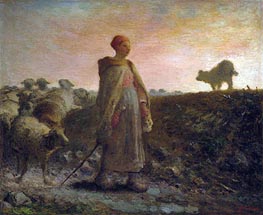
Shepherdess Returning with her Flock n.d.
Oil Painting
$874
$874
Canvas Print
$59.26
$59.26
SKU: MJF-8378
Jean-Francois Millet
Original Size: 44.4 x 53.9 cm
Private Collection
Jean-Francois Millet
Original Size: 44.4 x 53.9 cm
Private Collection
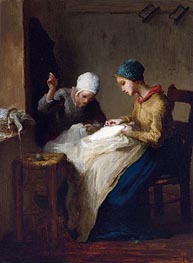
The Young Seamstresses 1850
Oil Painting
$628
$628
Canvas Print
$49.43
$49.43
SKU: MJF-8379
Jean-Francois Millet
Original Size: 32.7 x 24.4 cm
Private Collection
Jean-Francois Millet
Original Size: 32.7 x 24.4 cm
Private Collection
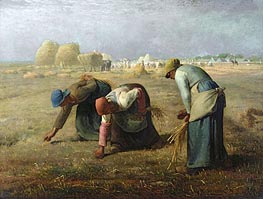
The Gleaners 1857
Oil Painting
$1060
$1060
Canvas Print
$55.98
$55.98
SKU: MJF-10549
Jean-Francois Millet
Original Size: 83.5 x 110 cm
Musee d'Orsay, Paris, France
Jean-Francois Millet
Original Size: 83.5 x 110 cm
Musee d'Orsay, Paris, France
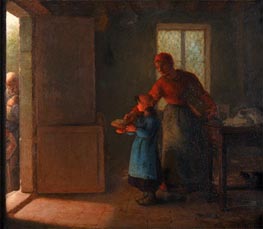
The Charity c.1858/59
Oil Painting
$637
$637
SKU: MJF-16648
Jean-Francois Millet
Original Size: 40 x 45 cm
Private Collection
Jean-Francois Millet
Original Size: 40 x 45 cm
Private Collection

The Cousin Hamlet at Greville 1854
Oil Painting
$929
$929
Canvas Print
$59.11
$59.11
SKU: MJF-18948
Jean-Francois Millet
Original Size: 74 x 92.3 cm
Musee des Beaux Arts, Reims, France
Jean-Francois Millet
Original Size: 74 x 92.3 cm
Musee des Beaux Arts, Reims, France

Shepherd Guarding his Flock c.1865
Paper Art Print
$53.44
$53.44
SKU: MJF-18949
Jean-Francois Millet
Original Size: 74.7 x 98.4 cm
Musee des Beaux Arts, Reims, France
Jean-Francois Millet
Original Size: 74.7 x 98.4 cm
Musee des Beaux Arts, Reims, France
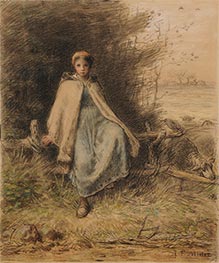
Young Shepherdess Sitting on a Fence c.1866/68
Paper Art Print
$47.07
$47.07
SKU: MJF-18950
Jean-Francois Millet
Original Size: 45 x 37.3 cm
Musee des Beaux Arts, Reims, France
Jean-Francois Millet
Original Size: 45 x 37.3 cm
Musee des Beaux Arts, Reims, France
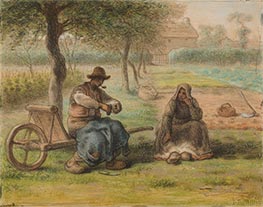
Rest in the Middle of the Day c.1865
Paper Art Print
$47.07
$47.07
SKU: MJF-18951
Jean-Francois Millet
Original Size: 36.5 x 46 cm
Musee des Beaux Arts, Reims, France
Jean-Francois Millet
Original Size: 36.5 x 46 cm
Musee des Beaux Arts, Reims, France
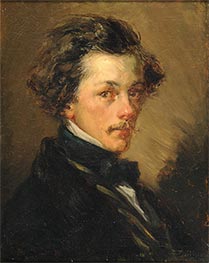
Portrait of an Anonymous Man c.1845
Oil Painting
$556
$556
Canvas Print
$49.43
$49.43
SKU: MJF-18952
Jean-Francois Millet
Original Size: 40.8 x 32.7 cm
Musee des Beaux Arts, Reims, France
Jean-Francois Millet
Original Size: 40.8 x 32.7 cm
Musee des Beaux Arts, Reims, France
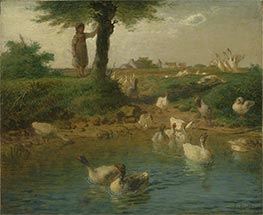
The Goosegirl c.1866/67
Oil Painting
$555
$555
Canvas Print
$61.16
$61.16
SKU: MJF-18983
Jean-Francois Millet
Original Size: 45.7 x 56 cm
Fuji Art Museum, Tokyo, Japan
Jean-Francois Millet
Original Size: 45.7 x 56 cm
Fuji Art Museum, Tokyo, Japan